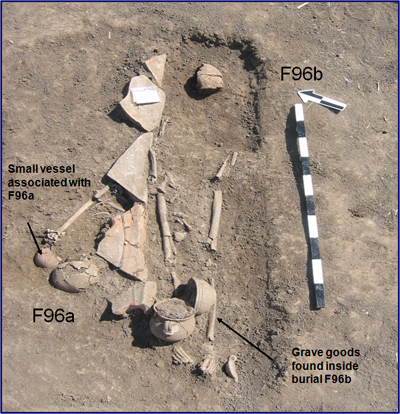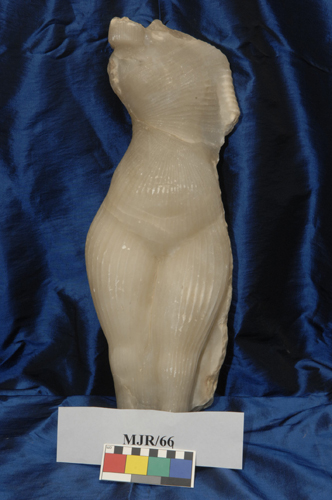The King Tut results are in and right now everyone is going gaga over the fact that malaria appears to have played a role in the boy king’s death. While this is an interesting find, there is another discovery – King Tut looked fairly normal, or at least he did not have a significantly bizarre or feminine physique – which also carries major implications for Ancient Egyptian research. First a bit of background. During the reign of Akhenaten(who is probably Tut’s father)Egyptian art became, well, very weird. The formal prose that the Egyptians had followed for thousands of years was…
-
-
A researcher has uncovered evidence of a widespread scam in Israel that results in tourists buying recently looted artefacts without their knowledge. Buying antiquities in Israel is legal if they were found before 1978, the year a major antiquities law was passed. There are numerous dealers in Israel, who are required to register with the Israel Antiquities Authority and keep an inventory of the artefacts they have for sale. Dr. Morag Kersel, of Brown University in the United States, has been studying the illegal antiquities trade in Israel, Jordan and the Palestinian Territories. Dr Kersel has been conducting interviews with…
-
Who is the man in this picture? How did this fellow, whose maternal ancestry is East Asian, end up in a modest grave in southern Italy about 2000 years ago? Its an enticing question and one that has been in the news ever since Heritage Key announced the story of this mans discovery. Just a quick recap; a team of scientists based at McMaster University in Hamilton Canada have found that this man, buried in a Roman cemetery at Vagnari, in southern Italy, is of East Asian ancestry on this mothers side. They determined this through mitochondrial DNA testing. The…
-
Did the ancestors of todays Inuit race across the arctic 750 years ago in search of meteorites?Canwest News Services has just published an intriguing story that suggests just that. According to the news service, Dr. Robert McGhee, curator emeritus at the Canadian Museum of Civilization, recently published this theory in a new book, The Northern World: AD 900 to 1400. Basically the idea works like this. 10,000 years ago a meteorite crashed into west Greenland, its known today as the Cape York meteorite. Mining in the arcticwas quite difficult (even today) so an iron meteorite was very handy for anyone…
-
News of this exhibit has been leaking out in bits and pieces for weeks. But today the official announcement of it was made and full details have been released. The exhibit will be hitting the Royal Ontario Museum in Toronto Canada starting in late June. The precise exhibition start/end dates are being arranged. As reported earlier the exhibit will be stopping at the Glenbow Museum in Calgary and the Royal BC Museum in Victoria BC. A stop in Montreal was announced several months back. Also, as hk previously reported, this will be the biggest Terracotta Warriors exhibition ever to hit…
-
A team of researchers annouced a surprising discovery during a scholarly presentation in Toronto last Friday. The research team, based at McMaster University in Hamilton, Canada, has been helping to excavate an ancient Roman cemetery at the site of Vagnari in southern Italy. Led by Professor Tracy Prowse, theyve been analyzing the skeletons found there by performing DNA and oxygen isotope tests. The surprise is that the DNA tests show that one of the skeletons, a man, has an East Asian ancestry on his mothers side. This appears to be the first time that a skeleton with an East Asian…
-
The official announcement is coming a week today (January 27) but news continues totrickle out about the exhibition of the Terracotta Warriors of the First Emperor, Qin Shi Huang, set to hit Toronto in June. Officials have been tight-lipped about this exhibit so what we’ve been hearing has been in drips and drabs. Last week we learned that the Toronto show is going to be the largest Terracotta Warrior’s showever to hit North America. We also learned that it will likely be one of four Canadian stops -with Toronto coming up first. There will be a Canadian tour, Montreal has…
-
This Saturday the Victoria and Albert Museum in London will open a show that is all about a fake, in partnership with Scotland Yard. The exhibit, Metropolitan Police Service’s Investigation of Fakes and Forgeries, will explore the work of counterfeit mastermind Shaun Greenhalgh, and reveal some of the techniques used by the police to spot fakes. Over a 17 year period Greenhalgh created fake art pieces that fooled museum experts and sold for sums as high as six figures. Sentenced in 2007 he is currently serving a four year prison sentence. His parents Olive and George Greenhalgh, who assisted in…
-
Ontarios Minister of Culture, Aileen Carroll, wastossed out of cabinet today as part of a larger shuffle.She will now become a backbench member of the legislature. The decision caught members of the media off-guard. The National Post said that, Ms. Carroll’s demotion is perhaps the most surprising. A former federal minister, the Barrie MPP was considered a high profile candidate in 2007. The Toronto Star writes that she may have made a decision not to run in the next general election. In Canadian politics it is not unusual for retiring ministers to get dumped from cabinet before they actually retire.…
-
Yesterday was an exciting day for those in Toronto who are interested in archaeology. Heritage Key learned that the Terracotta Warriors exhibit, coming to Toronto in June, will be the largestwarriors exhibitever to hit North America. No terracotta spectacle on this scale has ever come to these shores! But thats not all. Earlier in the day there was an announcement made by Canadas infrastructure minister John Baird. He said that the Canadian government will commit $2.75 million towards the construction of new Roman and Byzantine galleries at the Royal Ontario Museum.It will also be usedinrevamping thebat cave,” – a facsimile…



